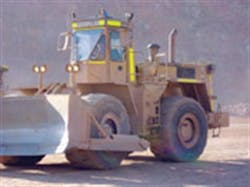If you talk to commercial tire dealers who repair OTR tires, most of them will tell you that 2007 was a banner year, while the outlook for 2008 is just as good, if not better.
With current demand for giant OTR tires continuing to exceed global supply, the mining and construction industries will do whatever it takes to keep their tires in service.
For dealers who are already in the OTR tire repair business, the shortage has created a modern-day Gold Rush. For those getting in the game late, every move is crucial.
Global OTR tire production is going to increase as existing plants ramp up and new plants open. There will come a time when supply of tires will meet and exceed demand.
Over the last year, I’ve spent a lot of time learning about the business of manufacturing, servicing, retreading and repairing giant tires. Commercial Tire Dealer has asked me to put this knowledge to good use with a list of “do’s” and “don’ts.” Since my New Year’s resolution is to be more positive, let’s start with a do:
[PAGEBREAK]
DO a lot of research before you decide to get in the OTR tire repair business. In order for any OTR tire repair operation to succeed, there has to be a regular supply of customers.
It’s important to remember that worldwide OTR tire production capacity will be increasing in a few years. For those who are properly positioned in the market, there shouldn’t be any changes because tires are still going to need to be repaired. For those who speculate that the current amount of OTR tire repair business will always be there, I wish them luck.
DON’T push beyond recommended repair limits. Without a doubt, this is the biggest “don’t” I can think of. With no sign of an immediate end to the OTR tire shortage, there is more pressure than ever for companies to make exceptions in the event of otherwise non-repairable injuries. I’ve seen what 100 pounds of air in a medium truck tire can do to a steel safety cage; I can only imagine what happens when an OTR tire fails in service.
DO select the right technicians. While the best materials and equipment in marginally trained hands will yield marginal results, adequate materials and equipment in the hands of well-trained technicians will probably yield excellent results. OTR tire repair is no place for clock-punchers or short-cutters whose favorite words are “close enough.” One cable that isn’t trimmed all the way back to solid rubber can cause a repair to fail. Techs who take a tremendous amount of pride in their craftsmanship make perfect OTR tire repair people.
DON’T let anyone mess with the OTR tire repair system. OTR tire repair and equipment manufacturers spend thousands of dollars developing products that can withstand the incredible amount of stress that’s applied to a tire once it returns to service. Tinkering with cure times, injury preparation angles and other details can be both dangerous and expensive. Unlike medium truck tires, where a mistake can easily be replaced with another casing, the value and availability of OTR casings is significantly different. The OTR repair shop is no place for experimentation.
DO consider other applications before making the decision to repair. OTR tires operate in every imaginable condition. High speed and high load applications are going to create a lot of heat. It may be best to send a marginal tire back to the customer, even if the injury is within limitations.
It also is important to have some idea of the level of maintenance that will accompany the tire after it has been returned to service. This is a situation in which open, honest communication with end users is crucial.
[PAGEBREAK]
DON’T repair OTR tires that are improperly supported. Most OTR tires are heavy enough to seriously or fatally injure anyone unfortunate enough to find himself underneath one.
Wedging wood blocks under the tread might be sufficient when a tire is being stored, but when someone is working on or inside the tire, there must be a system to secure the tire so it cannot fall on anyone.
Quality repair stands are often very expensive, but everyone from your insurance company to your employees will be grateful that safety is a priority when the potential for such a serious accident is always present.
DO get your techs the right tools to make their jobs easier. Sure, hand stitchers are a lot less expensive than pneumatic hammers, but the likelihood of trapped air is a lot less when the technician doesn’t have to exert so much physical effort. Every insurance company on the planet knows that workplace injuries and repetitive motion issues can typically be avoided when the proper equipment is available.
Right now, OTR tire users are going to tolerate everything, from the quality of the repair to the time it takes to get the tire back because they don’t have many options.
For those who have begun or want to reap the benefits of the shortage, it’s important to recognize that this Gold Rush will end.
Only those companies who have built solid relationships with their customers can expect to maintain their profitability once supply issues have been resolved.
This article is part of an exclusive on-going series written for CTD by Kevin Rohlwing, senior vice president of training for the Tire Industry Association.




